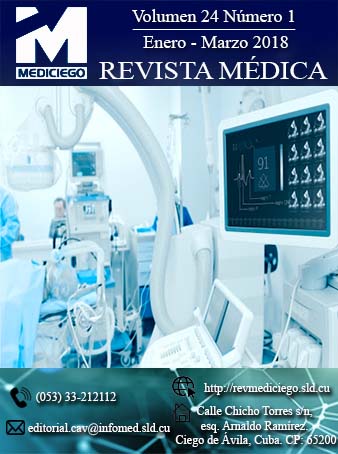Canine autotransplant as a therapeutic option to correct malocclusions
Abstract
Introduction: dental autotransplant is performed more frequently in patients with dentoalveolar trauma. In cases of dental losses for other reasons, the osseointegrated implant is currently used, so the former has been relegated.
Objective: to present the case of a patient who underwent autotransplantation of an upper canine as a therapeutic option to correct malocclusion.
Case presentation: female patient, 22 years old, with the left upper canine retained. Six months ago a tie was carried out during an active treatment in orthodontics. The x-ray showed the impacted canine and angulation that made orthodontic movement difficult. In the surgical procedure, the canine autologous technique was used. She had no surgical complications and evolved satisfactorily.
Discussion: dental retention is characterized by the lack of eruption of the tooth and a set of alterations. It occurs most frequently in adolescents and young adults, and is related to the eruption of third molars and canines. The treatment of choice is the relocation of the tooth included in the dental arch, and can be done through surgical-orthodontic or surgical procedures.
Conclusions: dental autotransplantation is a viable option to treat malocclusions. The functionality of the transplanted tooth was good, as well as its aesthetics and integration. Although the use of this technique is limited to the donor tooth, if it meets the conditions to perform the transplant, it should be considered.Downloads
Published
How to Cite
Issue
Section
License
Copyright (c) 2021 Niorgy Rodríguez Rodríguez, Danay Morgado Serafín, Manuel de Jesús Díaz Hernández

This work is licensed under a Creative Commons Attribution 4.0 International License.
Those authors who have publications with this journal accept the following terms of the License CC Attribution-NonCommercial 4.0 International (CC BY-NC 4.0):
You are free to:
- Share — copy and redistribute the material in any medium or format for any purpose, even commercially.
- Adapt — remix, transform, and build upon the material for any purpose, even commercially.
The licensor cannot revoke these freedoms as long as you follow the license terms.
Under the following terms:
- Attribution — You must give appropriate credit , provide a link to the license, and indicate if changes were made . You may do so in any reasonable manner, but not in any way that suggests the licensor endorses you or your use
- No additional restrictions — You may not apply legal terms or technological measures that legally restrict others from doing anything the license permits.
The journal is not responsible for the opinions and concepts expressed in the works, which are the exclusive responsibility of the authors. The Editor, with the assistance of the Editorial Committee, reserves the right to suggest or request advisable or necessary modifications. Original scientific works are accepted for publication, as are the results of research of interest that have not been published or sent to another journal for the same purpose.
The mention of trademarks of specific equipment, instruments or materials is for identification purposes, and there is no promotional commitment in relation to them, neither by the authors nor by the editor.






















